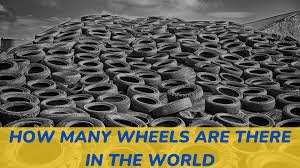How-many-wheels-are-in-the-world is one of those deceptively simple questions that can keep an insomniac awake far past midnight. At first glance it sounds like classic pub trivia, yet the moment you try to pin down a number you tumble into an energetic maze of technology, logistics, and culture. In asking how-many-wheels-are-in-the-world, we are really asking how modern life moves—literally and figuratively—because every wheel hints at a story of human ambition rolling forward.
The Magnetic Pull of a Spinning Mystery
Why does how-many-wheels-are-in-the-world grip the imagination so tightly? For one thing, wheels are everywhere yet rarely noticed; they are the ultimate background players. Cars and bicycles showcase them openly, but conveyor belts, rolling office chairs, toy cars, and even pocket fidget spinners all rely on the same humble principle. Tallying them reveals the vast plumbing that keeps global commerce, travel, and play in constant motion.

Cars: Our First Counting Stop
A logical starting point in the how-many-wheels-are-in-the-world quest is the automobile. The planet currently maintains about 1.5 billion passenger vehicles. Multiply by four wheels per car and you arrive at six billion wheels in one confident swoop. Yet that clean math splinters almost immediately—think three-wheeled tuk-tuks in Bangkok, eight-wheeled monster trucks at county fairs, and twelve-wheeled articulated buses in bustling capitals. The second you feel certain, how-many-wheels-are-in-the-world laughs and adds another axle.
Bicycles: The Silent Wheel Multiplier
Next, consider the trusty bicycle. With more than two billion bikes currently in service, the world gains another four billion wheels—sling-shotting our total past ten billion. Throw in recumbent trikes, cargo bikes sporting a third wheel, and millions of detachable training wheels on children’s cycles, and suddenly how-many-wheels-are-in-the-world jumps yet again.
The Office Chair Surprise
Step inside an office tower and you’ll meet the stealthiest contributors to how-many-wheels-are-in-the-world: swivel chairs. A typical ergonomic chair rolls on five casters, and a 2023 facilities survey counted roughly 230 million such chairs worldwide. That alone amounts to 1.15 billion extra wheels hidden beneath desks and conference tables—wheels few people remember until one jams during a video call.
Luggage, Strollers, and the Rolling Everyday
Now imagine every rolling suitcase clattering across airport terminals and each baby stroller cruising through city parks. Roughly 300 million suitcases change hands every year, most with four wheels, while an estimated 75 million strollers enter the market annually, many boasting six wheels. Add in hand trucks, dollies, shopping carts, and hospital beds and the how-many-wheels-are-in-the-world total balloons faster than a child’s first bike tire.
Hidden Wheels Behind the Curtain
The drama deepens inside warehouses where miles of conveyor belts rely on thousands of tiny rollers—mini-wheels that qualify by any sensible definition. A single e-commerce fulfillment center can harbor half a million of them. Factor in factory assembly lines, grain elevators, amusement-park rides, and laboratory centrifuges, and how-many-wheels-are-in-the-world begins to look as incalculable as the stars overhead.
Are Gears, Steering Wheels, and Roulette Wheels Fair Game?
Philosophical detours lurk everywhere. Mechanically speaking, a gear is a wheel with teeth, and a roulette wheel certainly rotates on an axle. Parents vacuum up untold billions of LEGO wheels each year. Hamster wheels spin in bedroom corners while ship steering wheels turn on salty bridges. The broader you cast the definition, the larger how-many-wheels-are-in-the-world becomes—an elastic figure that mirrors the very creativity of humankind.
Attempting a Conservative Estimate
Researchers who prefer to keep definitions tight—“a circular object that rotates on an axle to facilitate motion or transfer force”—have attempted a top-down calculation. A 2022 meta-study that combined automotive, bicycle, furniture, toy, and industrial production numbers landed near 37 billion wheels currently in active use. When they added spares in storage, seasonal equipment, and hobbyist stockpiles, the working figure crept toward 40 billion. Even that cautious number frames how-many-wheels-are-in-the-world as a staggering monument to humankind’s need to move.
A Moving Target—Literally
Every ten seconds a new vehicle rolls off an assembly line somewhere on Earth, introducing four to twelve fresh wheels. At the same time, scrapyards strip rusting cars and recycle their rims. The relentless cycle of birth and retirement means how-many-wheels-are-in-the-world changes as quickly as global traffic conditions. In that sense, the count behaves like a living organism, growing and shrinking in rhythm with consumer demand and environmental policy.
Tomorrow’s Trends: Adding or Subtracting?
Do future cities hold more wheels or fewer? Urban planners forecast declining private-car ownership, hinting at a plateau. Yet e-commerce keeps demanding last-mile delivery robots, each with six stubby wheels. Maglev luggage systems in airports could eliminate millions of rollers, while micromobility companies flood streets with e-scooters and e-skateboards—every new gadget adding two or four wheels to the ledger. Clearly, the trajectory of how-many-wheels-are-in-the-world will mirror the tug-of-war between convenience, technology, and sustainability.
Turn Your Errand into a Wheel-Spotting Game
Want a personal glimpse of the scale? The next time you visit the grocery store, count wheels along the way. Your own car contributes four. A shopping cart adds another four. Each display rack often rides on four or six hidden casters. Delivery trucks out back might rest on eighteen apiece. You will soon realize that in a single mundane outing you’ve strolled past hundreds, perhaps thousands, of devices feeding the ever-growing total of how-many-wheels-are-in-the-world.
The Takeaway: Joy in the Journey
Ultimately, no spreadsheet can capture a final, unchanging answer to how-many-wheels-are-in-the-world. Even a figure hovering around 40 billion is a snapshot rather than a conclusion. What endures is the sense of wonder that springs from the attempt. Every wheel—large or small, rubber or steel, powered by foot, engine, or gravity—embodies human ingenuity and our shared desire to keep life rolling forward. So the next time the question flashes across your feed, smile and remember that while we may never notch a perfect total, the quest itself keeps curiosity—and the world—spinning.
